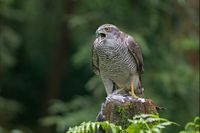Accipiter Hawk
 From Conservapedia
From Conservapedia | Accipiter hawk | |
|---|---|

| |
| Northern goshawk Accipiter gentilis | |
| Scientific classification | |
| Kingdom Information | |
| Domain | Eukaryota |
| Kingdom | Animalia |
| Subkingdom | Bilateria |
| Branch | Deuterostomia |
| Phylum Information | |
| Phylum | Chordata |
| Sub-phylum | Vertebrata |
| Infraphylum | Gnathostomata |
| Class Information | |
| Superclass | Tetrapoda |
| Class | Aves |
| Sub-class | Neornithes |
| Infra-class | Neoaves |
| Order Information | |
| Order | Accipitriformes |
| Sub-order | Accipitres |
| Family Information | |
| Superfamily | Accipitroidea |
| Family | Accipitridae |
| Sub-family | Accipitrinae |
| Genus Information | |
| Genus | Accipiter |
| Population statistics | |
Accipiter hawk refers to 48 species of bird of prey, whose primary characteristic as opposed to the buteo or buzzard hawks is the ability to hunt in dense woodlands. Small to medium-sized, accipiter hawks bear short, rounded wings and long tails, making them highly maneuverable in forests.
Contents
- 1 Description
- 2 Range and habitat
- 3 Diet and hunting
- 4 Reproduction
- 5 Species
Description[edit]
Accipiter hawk females are significantly larger than the males, the dimensions overlap only slightly. In some of the pure bird hunters, this reverse sex dimorphism is the most pronounced among all birds of prey. Among the smallest species, such as the tiny hawk (Accipiter superciliosus), the males have a length of 7.8 inches and a body weight of 2.1 ounces, while the female of largest species, the northern goshawk (Accipiter gentilis), has a length of up to 24.8 inches long and a body weight of up to 4.8 pounds.
In almost all species, the top is very dark gray or blackish and the underside is a sharply contrasting light color, with finely transversed barring. In particular tropical species are often characterized by reddish tints on the underside and the neck very colorful. Flight and tail feathers are usually darkly banded. Young birds are generally much less strikingly colored and, on the other hand, mostly brownish and on the other side lighter brownish with dark lines.
The typical proportions are well recognizable even in the flight, almost all kinds also have a typical flight mode with some fast wing kicks and a subsequent short gliding phase. These hawks also show a very upright posture when perched, which often allows for the determination of the genus at a very great distance.
Range and habitat[edit]
Accipiter hawks are found on all continents except Antarctica, with most species living in the tropics. The greatest diversity of species is in Southeast Asia and Oceania, where numerous species are endemic on individual islands or groups of islands. All species show a close connection to forests or at least woody habitats.
Diet and hunting[edit]
Accipiter hawks hunt their prey mainly from a short, fast pursuit flight near ground level upwards towards the canopy. Natural structures such as hedges, trees, and houses are also used very cleverly for a covered approach. The birds are extremely agile when hunting.
Many species are specialized birdwatchers, but a number of other species kill a wide range of vertebrate animals as well as insects, with birds often only a small part of the diet.
Reproduction[edit]
All species, as far as known, are monogamous and strictly territorial. The nest is made of interwoven branches on trees. The incubation of the eggs and the care of the small birds is carried out almost exclusively by the female, while the male feeds the female and then the chicks with food.
Species[edit]
- African goshawk, Accipiter tachiro
- Besra, Accipiter virgatus
- Bicoloured hawk, Accipiter bicolor
- Black goshawk, Accipiter melanoleucus
- Black-mantled goshawk, Accipiter melanochlamys
- Brown goshawk, Accipiter fasciatus
- Chestnut-flanked sparrowhawk, Accipiter castanilius
- Chinese goshawk, Accipiter soloensis
- Collared sparrowhawk, Accipiter cirrocephalus
- Cooper's hawk, Accipiter cooperii
- Crested goshawk, Accipiter trivirgatus
- Eurasian sparrowhawk, Accipiter nisus
- Fiji goshawk, Accipiter rufitorques
- Frances' sparrowhawk, Accipiter francesiae
- Gray goshawk, Accipiter novaehollandiae
- Gray-bellied goshawk, Accipiter poliogaster
- Gray-headed goshawk, Accipiter poliocephalus
- Gundlach's hawk, Accipiter gundlachi
- Henst's goshawk, Accipiter henstii
- Imitator sparrowhawk, Accipiter imitator
- Japanese sparrowhawk, Accipiter gularis
- Levant sparrowhawk, Accipiter brevipes
- Little sparrowhawk, Accipiter minullus
- Madagascar sparrowhawk, Accipiter madagascariensis
- Meyer's goshawk, Accipiter meyerianus
- Moluccan goshawk, Accipiter henicogrammus
- New Britain goshawk, Accipiter princeps
- Nicobar sparrowhawk, Accipiter butleri
- Northern goshawk, Accipiter gentilis
- Ovambo sparrowhawk, Accipiter ovampensis
- Pied goshawk, Accipiter albogularis
- Plain-breasted hawk, Accipiter striatus ventralis
- Red-chested goshawk, Accipiter toussenelii
- Red-thighed sparrowhawk, Accipiter erythropus
- Rufous-chested sparrowhawk, Accipiter rufiventris
- Rufous-necked sparrowhawk, Accipiter erythrauchen
- Rufous-thighed hawk, Accipiter striatus erythronemius
- Semicollared hawk, Accipiter collaris
- Sharp-shinned hawk, Accipiter striatus
- Shikra, Accipiter badius
- Slaty-mantled sparrowhawk, Accipiter luteoschistaceus
- Small sparrowhawk, Accipiter nanus
- Spot-tailed goshawk, Accipiter trinotatus
- Sulawesi goshawk, Accipiter griseiceps
- Tiny hawk, Accipiter superciliosus
- Vinous-breasted sparrowhawk, Accipiter rhodogaster
- White-bellied goshawk, Accipiter haplochrous
- White-breasted hawk, Accipiter striatus chionogaster
Categories: [Birds of Prey] [Accipiter Hawks]
↧ Download as ZWI file | Last modified: 02/14/2023 22:43:03 | 23 views
☰ Source: https://www.conservapedia.com/Accipiter_hawk | License: CC BY-SA 3.0
 ZWI signed:
ZWI signed: KSF
KSF